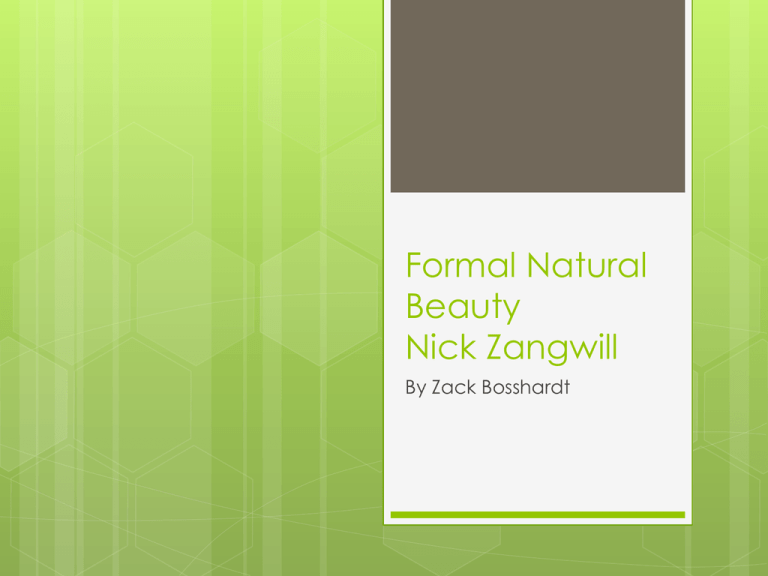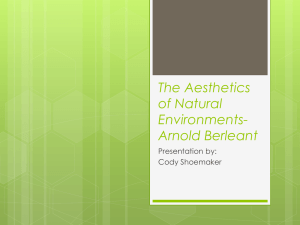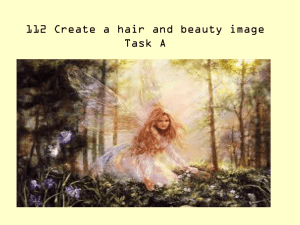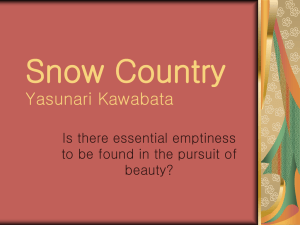Formal Natural Beauty nick zangwill
advertisement

Formal Natural Beauty Nick Zangwill By Zack Bosshardt Overview of the paper Moderate Formalism – Although anti-formalist approaches are sometimes appropriate, “… anti-formalists cannot account for the incongruousness of much natural beauty.” p.209 We should appreciate both formal and categorical or dependent beauty. Strict Formalism of Inorganic Beauty – Since an inorganic thing has no purpose or function, and thus is not dependent upon ‘kinds’, only the formalistic appearances of the thing are pertinent for aesthetic appreciation. Problems with Formalism The Frame Problem The Magnification Problem Active Appreciation Conclusion – “In sum, moderate formalism about the aesthetics of nature is not only unproblematic but also attractive.” p.223 Distinction Formal Beauty – “Some beauty does not express a function, but depends entirely on how the thing is considered in itself.”p.209 Dependent Beauty- “Things that are dependently beautiful have a function, and they have a beauty that expresses or articulates that function.” p.209 Dependent Beauty – appreciating a thing as its kind or category Strict Categories- Carlson’s scientific categories. Looser Categories- Common sense categories are sufficient for appropriate appreciation. More on Dependent Beauty The Qua Thesis: Natural things have their aesthetic properties qua (by virtue of) the natural kinds they are members of. Carlson’s Strong Qua Thesis - “We must appreciate a natural thing as a particular kind of natural thing it is.” p.210 That is, we appreciate in either scientific or common sense categories. Budd’s Weak Qua Thesis – We must appreciate natural things as nature. ‘Natural’ is a sufficient category. Zangwill’s View – Both should be resisted, as nature can have “purposeless beauty.” Sometimes we must appreciate according to dependent beauty in the case of organic nature, but never in inorganic nature. ‘Methodological Reflections’ Intuitions and Formalist Scenarios In these scenarios, lacking knowledge or categorization results in the same aesthetic experience as having it. Apparent differences found in responses might in fact be non-aesthetic. 1. Silk flowers that are exactly the same as real flowers 2. Fjords being artificially constructed. 3. Theist versus the atheist viewing nature as art. These examples appeal to our intuitions already present. The anti-formalist has different intuitions. Qualess (formal) Beauty In certain scenarios, “…biological things have aesthetic properties that are not dependent on their biological kind.” Examples of Qualess Beauty Whale Example- Is there a difference between aesthetically appreciating a whale in the category of mammal or fish? Polar Bear Example- The daintiness of a polar bear swimming. “Its aesthetic character (daintiness) had nothing to do with its being a polar bear.” p.215 More on the Polar Bear example 3 Ways to View the Polar Bear: Beautiful Living Thing (strong qua thesis) Beautiful Natural Thing (weak qua thesis) Beautiful Thing – The bear is ‘formally extraordinary’, and we would have the same aesthetic experience whether the bear was in fact a man in a suit, a fish, or an artifact. The daintiness we observe is surprising when thinking of the bear categorically as a “strong, vigorous, powerful.” (p.215) “Its aesthetic character had nothing to do with its being a polar bear.” Nature can be surprising in its beauty and aesthetic qualities when considering certain scientific facts we know about it. Carlson’s potential reply- although this ‘beautiful thing’ response is present, it is less important/deeper/momentous/valued than a scientific cognitivist approach. Extreme Formalism and Inorganic natural beauty Since inorganic nature is without purpose or function, then a specific category cannot be given. Resultantly, no dependent beauty can arise, and thus only formalistic appreciation is available. The Mud Flat problem – part versus whole gives different wider or narrower formalistic responses. (more on this later) Zangwill’s Problems with Moderate Formalism The Frame Problem The Magnification Problem Active Appreciation The Frame Problem Art is framed, while nature is not. How are we to frame nature for appreciation? Depending upon the framing, won’t we have fluctuations in our aesthetic response? Solution – whatever the frame may be of nature, large or narrow, one’s appreciation ought always to be positive, because all nature is more or less beautiful. There are no contradictions depending upon framing. “Many individually delicate things might be magnificently powerful in concert ( such as a hillside covered in flowering gorse),”p.220. Nature is aesthetically complex, and can be internally different, but not contradictory. Magnification Problem On what level are we to appreciate nature? A grain of sand can be appreciated by the naked eye, by a microscope, and so on. Which level is appropriate? Solution – Aesthetic appreciation is the sum of all levels of magnification And if these levels differ, even after appealing to positive aesthetics? “If we place ourselves differently, different aesthetic properties of nature become available to us,” (p.222) Analogy with paintings. Active Appreciation “One is immersed in nature, part of it, not distanced from it, as formalism seems to require,”(p.223). A formalist could appreciate a natural environment like a landscape painting. Solution- Our appreciation is frameless. We participate in, as well as formally appreciate, a 3-dimensional natural environment. Conclusion “In sum, moderate formalism about the aesthetics of nature is not only unproblematic but also attractive.” p.223 “Anti-formalists want us to appreciate nature with the eyes of a connoisseur. But I think that childlike wonder is often more appropriate.” p.224 Other Problems or Questions What amount of cognition or categorization do you allow in formalism? The mud flat example – A vs. B In what scenarios is the formalist approach more appropriate than the dependence approach in moderate formalism? The polar bear example dealing with function. General Overview - Norms Carlson– Only categories, specifically scientific ones, are appropriate for aesthetic appreciation. Scientists are most attuned to these categories and are thus most able to appreciate natural settings appropriately. Dr. Parsons- On scientific cognitivism with two approaches from his lecture; consequentialism and ‘respect.’ Zangwill Approach – Both formalistic and categorical (cognitivist) approaches are appropriate. Heyd Approach – more aesthetic experience is better than less, so any approach (including formalism) is appropriate if it increases aesthetic attention. Intrinsic worth of aesthetic experience? (there are other norms we’ve discussed about emotion, imagination, and so on.) Other appeals for Formalism that I can think of: Formalist experience is available to everyone, not just the educated few. Divorcing practical concerns (consequentialism) and ethics from aesthetic judgments in nature can lead to easier acceptance of a formalistic approach. Pollution sunset, green lawns, invasive flowers. Destroying beautiful things-Hopefully ethics or practical concerns will out-weigh aesthetic concerns in these examples. Dealing with the respect argument – inter-subjectivity of formalistic response (like the emotion paper). Mind-independent properties









